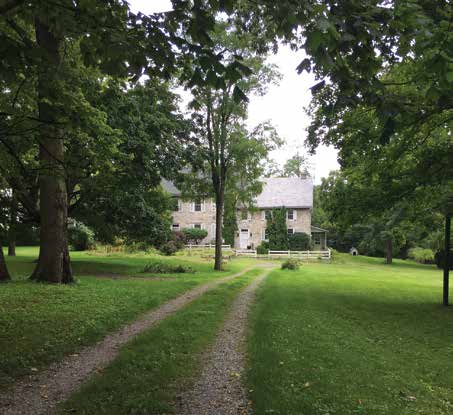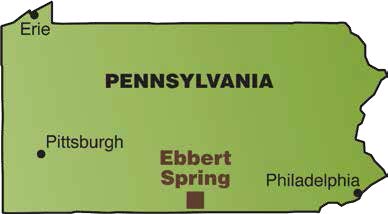In 2010 the Conservancy negotiated an agreement with a real estate developer to acquire a 3.4-acre parcel of land in the center of a large industrial development in Antrim Township in south-central Pennsylvania. The parcel contained a portion of Ebbert Spring, a multi component site with artifacts spanning from the Paleo-Indian period to the nineteenth century. The site is centered around a spring that produces approximately 700 gallons of water per minute and now serves the surrounding community.
Fall 2018 the Conservancy acquired an additional five acres of the site, known as the Bonnell parcel. In addition to including the heart of the prehistoric component of the site, the Bonnell parcel also contains an eighteenth-century farmhouse and associated outbuildings.
Ebbert Spring was first excavated by a chapter of the Society for Pennsylvania Archaeology in 2003. Over the course of the next ten years they recovered tens of thousands of historic items and prehistoric lithic, ceramic, and bone artifacts at the site; as well as various intact features such as postmolds, hearths, and refuse pits predominantly from the Middle and Late Woodland periods.
The prehistoric component of the site helped redefine thinking about how prehistoric people utilized this portion of the Great Appalachian Valley. Most Native American habitation areas in the region have been found near tributaries of the Potomac River, but Ebbert Spring is one of several documented sites in the valley located next to springs.
In addition to the site’s prehistoric significance, the historic buildings represent the only standing structures built by the Allison family, who came to the area from Ireland in the eighteenth century. John Allison served in the Revolutionary War and founded the nearby town of Greencastle. Historical documents indicate that his father, William Allison Sr. (who helped build the house at Ebbert Spring), agreed to build a private fort in the area to defend against attack. The exact location of the fort, known as Ft. Allison, has never been verified, though it’s possible that it’s the fortified springhouse at the site.
This fieldstone and brick springhouse appears to have been used as a French and Indian War fortification. Excavators discovered postmold features of a palisade around the structure along with gunflints, a spur, and other period artifacts. The springhouse was constructed directly above the spring so that water passes through a channel built into the floor, providing a constant flow of fresh water to the structure’s occupants. The fact that the springhouse is found in the front yard of the family commissioned to build the fort also supports the idea that it’s Ft. Allison, but more research is needed before a definitive determination can be made. All of the artifacts, notes, and maps from these excavations were collected by Conservancy staff and donated to the Allison-Antrim Museum in Greencaslte so that they will be available for future researchers.
Al Bonnell, who had owned this parcel until his passing in 2016, had devoted his life to restoring the house and to studying the history of the property. He wanted the entire site to be preserved, and his wishes are being honored by his son, Terry. Working closely with the Bonnell family, the Conservancy’s Eastern regional staff negotiated a bargain sale to charity to acquire the site. The staff also organized a powerful coalition of conservation allies involving local, regional, and state agencies.
Funding for the property was obtained from Antrim Township together with a matching grant from the Pennsylvania Department of Conservation and Natural Resources. Additional funding was also obtained from the Elfrieda Frank Foundation. The Conservancy’s partners in this project include Antrim Township, the Allison-Antrim Museum, the Pennsylvania Historical and Museum Commission, Shippensburg University, the Conococheague Institute, and the Greencastle-Antrim School District.
An interpretive trail featuring a series of kiosks will be installed at the site to tell the story of people at this location from 10000 b.c. to the present. The Allison-Antrim Museum has agreed to lease and care for all of the structures on the property. The eight-plus-acre site is expected to open to the public as the Ebbert Spring Archaeological Preserve and Heritage Park in August of 2019.
This story was published in American Archaeology, Fall 2017 | Vol. 21 No. 3.
American Archaeology is available on Newsstands and at Bookstores, or become a member of the Archaeological Conservancy to subscribe.
Ebbert Spring in the News:
- Big warehouses threaten Greencastle historic site Sept. 16, 2016
- Franklin County Visitors Bureau Highlights Ebbert Springs Archaeological Site in Greencastle PA Jan. 31, 2017
- Lease agreement allows for maintenance at Ebbert Spring park Sept. 4, 2017
- Heritage park to showcase local history & prehistory Sept. 5, 2017






